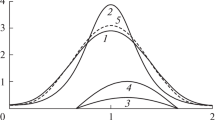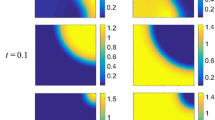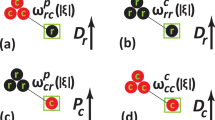Abstract
We employ Monte Carlo simulations to numerically study the temporal evolution and transient oscillations of the population densities, the associated frequency power spectra, and the spatial correlation functions in the (quasi-) steady state in two-dimensional stochastic May-Leonard models of mobile individuals, allowing for particle exchanges with nearest-neighbors and hopping onto empty sites. We therefore consider a class of four-state three-species cyclic predator-prey models whose total particle number is not conserved. We demonstrate that quenched disorder in either the reaction or in the mobility rates hardly impacts the dynamical evolution, the emergence and structure of spiral patterns, or the mean extinction time in this system. We also show that direct particle pair exchange processes promote the formation of regular spiral structures. Moreover, upon increasing the rates of mobility, we observe a remarkable change in the extinction properties in the May-Leonard system (for small system sizes): (1) as the mobility rate exceeds a threshold that separates a species coexistence (quasi-) steady state from an absorbing state, the mean extinction time as function of system size N crosses over from a functional form ∼ e cN/N (where c is a constant) to a linear dependence; (2) the measured histogram of extinction times displays a corresponding crossover from an (approximately) exponential to a Gaussian distribution. The latter results are found to hold true also when the mobility rates are randomly distributed.
Similar content being viewed by others
References
J.M. Smith, Evolution and the Theory of Games (Cambridge University Press, Cambridge, UK, 1982)
J. Hofbauer, K. Sigmund, Evolutionary games and population dynamics (Cambridge University Press, Cambridge, UK, 1998)
M.A. Nowak, Evolutionary Dynamics (Belknap Press, Cambridge, USA, 2006)
G. Szabó, Phys. Rep. 446, 97 (2007)
R.M. May, W.J. Leonard, SIAM J. Appl. Math. 29, 243 (1975)
R.M. May, Stability and Complexity in Model Ecosystems (Cambridge University Press, Cambridge, UK, 1974)
J.M. Smith, Models in Ecology (Cambridge University Press, Cambridge, UK, 1974)
R.E. Michod, Darwinian Dynamics (Princeton University Press, Princeton, USA, 2000)
R.V. Sole, J. Basecompte, Self-Organization in Complex Ecosystems (Princeton University Press, Princeton, USA, 2006)
D. Neal, Introduction to Population Biology (Cambridge University Press, Cambridge, UK, 2004)
L. Frachebourg, P.L. Krapivsky, J. Phys. A: Math. Gen. 31, L287 (1998)
B. Sinervo, C.M. Lively, Nature (London) 380, 240 (1996)
K.R. Zamudio, B. Sinervo, Proc. Natl. Acad. Sci. (USA) 97, 14427 (2000)
B. Kerr, M.A. Riley, M.W. Feldman, B.J.M. Bohannan, Nature (London) 418, 171 (2002)
T. Reichenbach, M. Mobilia, E. Frey, Nature (London) 448, 1046 (2007)
T. Reichenbach, M. Mobilia, E. Frey, Phys. Rev. Lett. 99, 238105 (2007)
T. Reichenbach, M. Mobilia, E. Frey, J. Theor. Biol. 254, 368 (2008)
T. Reichenbach, M. Mobilia, E. Frey, Banach Center Publications 80, 259 (2008)
M. Peltomäki, M. Alava, Phys. Rev. E 78, 031906 (2008)
T. Reichenbach, M. Mobilia, E. Frey, Phys. Rev. E 74, 051907 (2006)
M. Berr, T. Reichenbach, M. Schottenloer, E. Frey, Phys. Rev. Lett. 102, 048102 (2009)
L. Frachebourg, P.L. Krapivsky, E. Ben-Naim, Phys. Rev. E 54, 6186 (1996)
A. Provata, G. Nicolis, F. Baras, J. Chem. Phys. 110, 8361 (1999)
K.I. Tainaka, Phys. Rev. E 50, 3401 (1994)
G. Szabó, A. Szolnoki, Phys. Rev. E 65, 036115 (2002)
M. Perc, A. Szolnoki, G. Szabó, Phys. Rev. E 75, 052102 (2007)
G.A. Tsekouras, A. Provata, Phys. Rev. E 65, 016204 (2001)
Q. He, M. Mobilia, U.C. Täuber, Phys. Rev. E 82, 051909 (2010)
G. Szabó, A. Szolnoki, R. Izsák, J. Phys. A 37, 2599 (2004)
A. Szolnoki, G. Szabó, Phys. Rev. E 70, 037102 (2004)
J.C. Claussen, A. Traulsen, Phys. Rev. Lett. 100, 058104 (2008)
U. Dobramysl, U.C. Täuber, Phys. Rev. Lett. 101, 258102 (2008)
M. Mobilia, I.T. Georgiev, U.C. Täuber, J. Stat. Phys. 128, 447 (2007)
M.J. Washenberger, M. Mobilia, U.C. Täuber, J. Phys.: Condens. Matter 19, 065139 (2007)
M. Mobilia, J. Theor. Biol. 264, 1 (2010)
H. Touchette, Phys. Rep. 478, 1 (2009)
C.W. Gardiner, Handbook of Stochastic Methods, 2nd edn. (Springer-Verlag, Berlin, 2002)
Author information
Authors and Affiliations
Corresponding author
Rights and permissions
About this article
Cite this article
He, Q., Mobilia, M. & Täuber, U.C. Coexistence in the two-dimensional May-Leonard model with random rates. Eur. Phys. J. B 82, 97–105 (2011). https://doi.org/10.1140/epjb/e2011-20259-x
Received:
Published:
Issue Date:
DOI: https://doi.org/10.1140/epjb/e2011-20259-x




